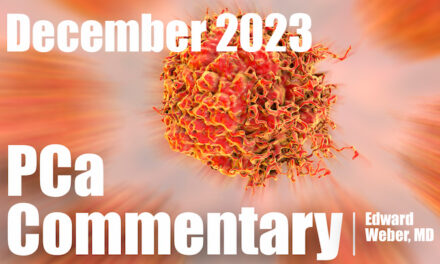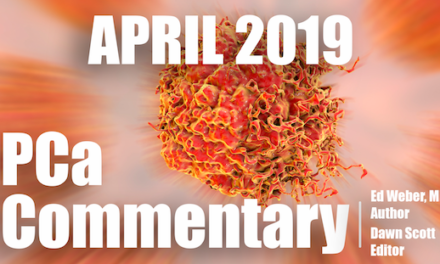
PCa Commentary | Volume 125 – August 2018
Posted by Edward Weber | July 2018
NEUROENDOCRINE PROSTATE CANCER: An Adverse Development in Advanced Disease — Which Largely Has Flown Under the Radar.
Neuroendocrine Prostate Cancer — What is it?
Neuroendocrine prostate cancer (NEPC) is a form of the disease which, as best currently understood, arises from standard adenocarcinoma in a process termed “transdifferentiation.” This transformation develops in advanced stages of prostate cancer—usually in metastatic CRPC, and is thought to result as an adaptation to the selective pressure of androgen deprivation. It’s usually seen after prior therapy with, for example, abiraterone and/or enzalutamide and is one source of resistance to these agents.
NEPC is heterogeneous. It can be found as a mixture—in varying degrees—in the same tumor mass with adenocarcinoma. Crosstalk between these two cell types goes both ways: partially transformed cells are driven to full transformation by signals from the adeno type, and NEPC cells in turn promote increasing mutations in the adenocarcinoma. In late-stage prostate cancer, NEPC may comprise as much as 25% of the disease burden. When extensively transformed, as in “pure” NEPC, these cells no longer secrete PSA and do not express the cell-surface marker PSMA. Instead, NEPC expresses membrane synaptophysin receptors, a well-recognized marker for these cells, and somatostatin receptors, the target for scanning with 68Gallium-labeled somatostatin analogues (e.g., 68Ga-DOTA-Octreotide PET/CT).
The prevalence of therapy-induced NEPC can be expected to increase. While the widespread use of androgen receptor inhibitors (i.e. Zytiga and Xtandi) prolongs survival, at the same time it induces neuroendocrine transformation. The recent greater awareness of neuroendocrine-like prostate cancer in late-stage disease arises from an increased use of biopsies into metastatic tumors.
The Diagnosis of NEPC is Elusive
Somatostatin receptors are not imaged by PSMA PET/CT, but can be imaged with an alternate scan, 68Ga-DOTA PET/CT. The difference in imageability between non-PSMA expressing neuroendocrine tumors and PSMA positive-adenocarcinomas was clearly demonstrated by a study in which an initial PSMA PET/CT scan detected numerous sites of metastatic cancer. These improved with anti-androgen receptor therapy and led to an undetectable PSA. A later follow-up PSMA scan was PET-negative but the CT portion of the scan showed numerous tracer-negative masses. These were avidly imaged with the DOTA scan detecting the somatostatin receptors, indicating that a neuroendocrine transformation had developed (Parida et al.,Clin Nucl Med. 2018).
The regularly available 18F-FDG PET/CT can image the metabolically active neuroendocrine masses. This scan employs radioactive glucose as the tracer, which is avidly taken up in NEPC tumors to support active cell proliferation.
Biopsies into metastatic sites can reveal the presence of NEPC. However, while any one or several sites could be NEPC positive, tumor heterogeneity can be diagnostically limiting since in a patient’s total tumor burden there can be separate tumors comprised of each type of cancer.
As stated by Himisha Beltran, MD, Weill Cornell Medical College, an expert in this field, “Oncologists should suspect NEPC in patients who have particularly aggressive metastatic castration-resistant disease that has failed to respond to typical cancer therapies, with progression in the setting of a low or non-rising PSA” (Clinical Advances in Hematology and Oncology, July 2016).
The NEPC cells secrete the neuropeptides chromogranin A (CGA) and neuron specific enolase. However in the article, “Serum chromogranin A as a complimentary marker for the prediction of prostate cancer specific survival,” Niedworok et al., found “no independently prognostic value for CGA as a single serum marker in clinically localized disease,” but levels were significantly higher in advanced cancer, suggesting a role for CGA in disease monitoring (Pathology Oncology Research. July 2017).
Researcher are pursuing synaptophysin staining of circulating tumor cells. The article “Synaptophysin expression on circulating tumor cells in patients with castration resistant prostate cancer undergoing treatment with abiraterone and enzalutamide” found that “baseline percentage CTC synaptophysin expression was significantly associated with [a shorter] time to progression” and expression “increased with the emergence of drug resistance” (Pal et al. Urologic Oncology. Dec 2017).
Treatment
Difficult as it is to make a diagnosis of NEPC, currently, treatment is even more challenging.
Two detailed research articles were directed to understanding the molecular underpinnings of NEPC—and aimed at developing the foundation for the search for treatment targets:
“Molecular model of neuroendocrine prostate cancer progression,” Chen, Dong, and Gleave, Vancouver Prostate Centre, BC, (BJU Int. 2018), reported on the drivers of transdifferentiation. They hope their research “offers a reference for rationales for designing new therapeutic targets for this disease.” Standard chemotherapy has only limited benefit. There is a great need for targeted agents for NEPC. They cite four ongoing clinical trials exploring new treatments. Also cited was one completed clinical trial which targeted the expression of the “NEPC-specific proliferation facilitator,” Aurora kinase (trial not yet reported). Only one of these trials includes chemotherapy.
“Clinical and genomic characterization of treatment-emergent small-cell neuroendocrine prostate cancer [t-SCPC]: a multi-institutional prospective study.” Aggarwal, Small, Gleave, et al., July 9, 2018, reported genomic analysis of biopsies into 160 metastatic sites in men with progressive CRPC.
The take-away points from this research relative to clinical management are as follows:
- “The identification of mixed histologic subtypes within a single metastatic site suggests that treatment-emergent small-cell neuroendocrine differentiation [i.e. NEPC] is a heterogeneous process.” Pure and partially transformed NEPC exhibit significant mutations found in the adenocarcinomas, suggesting that the transformed disease arises from the precursor adenocarcinoma.
- Of a total enrollment of 202 patients, “One hundred forty-eight (73%) had prior disease progression on abiraterone and/or enzalutamide.”
- Informative biopsies from metastatic sites were positive in 17% (27/160), occurring nearly equally in liver, lymph nodes, and bone with 20 showing pure NEPC and 7 a mixture of NEPC and adenocarcinoma.
- The study compared the diagnostic utility of the two serum markers known to be associated with NEPC: neuron specific enolase (NSE) and chromogranin A (CGA). They found that the best predictor for the presence of NEPC was a combination of NSE >6.05 ng/mL and CGA >3.1 ng/mL. This combo yielded a sensitivity of 95%. In patients whose combined levels were lower, the negative predictive value for NEPC was 98%. If validated, this information might suggest that a biopsy is unnecessary in cases where test values fall below this threshold.
- Pure and mixed NEPC/adenocarcinomas retain (but to a diminished extent) androgen receptor activity and continue to secrete PSA, but at lower levels compared to untransformed adenocarcinoma. The pure and mixed varieties both confer the same adverse survival prediction.
- The study found that “t-SCNC (aka NEPC) is present in nearly one fifth of patients with mCRPC.
Bottom Line
The development of NEPC is associated with reduced survival. Its prevalence is increasing partly as a result of beneficial treatment with Zytiga and Xtandi. Greater awareness of NEPC is leading to clinical and basic research to find targeted therapies.
Your comments and requests for information on a specific topic are welcome e-mail ecweber@nwlink.com. Please also visit https://prostatecancerfree.org/prostate-cancer-news for a selection of past issues of the PCa Commentary covering a variety of topics.
“I want to thank Dawn Scott, Staffperson, Tumor Institute Radiation Oncology Group, & Mike Scully, Librarian, Swedish Medical Center for their unfailing, timely, and resourceful support of the Commentary project. Without their help this Commentary would not be possible.”
ABOUT THE AUTHOR
Edward Weber, MD, is a retired medical oncologist living in Seattle, Washington. He was born and raised in a suburb of Reading, Pennsylvania. After graduating from Princeton University in 1956 with a BA in History, Dr. Weber attended medical school at the University of Pennsylvania. His internship training took place at the University of Vermont in Burlington.
A tour of service as a Naval Flight Surgeon positioned him on Whidbey Island, Washington, and this introduction to the Pacific Northwest ultimately proved irresistible. Following naval service, he received postgraduate training in internal medicine in Philadelphia at the Pennsylvania Hospital and then pursued a fellowship in hematology and oncology at the University of Washington.
His career in medical oncology was at the Tumor Institute of the Swedish Hospital in Seattle where his practice focused largely on the treatment of patients experiencing lung, breast, colon, and genitourinary cancer and malignant lymphoma.
Toward the end of his career, he developed a particular concentration on the treatment of prostate cancer. Since retirement in 2002, he has authored the PCa Commentary, published by the Prostate Cancer Treatment Research Foundation, an analysis of new developments in the prostate cancer field with essays discussing and evaluating treatment management options in this disease. He is a regular speaker at various prostate cancer support groups around Seattle.




